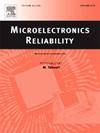Reliability study and optimization of TSV interconnections with silicon interposer under random vibration
IF 1.6
4区 工程技术
Q3 ENGINEERING, ELECTRICAL & ELECTRONIC
引用次数: 0
Abstract
As aerospace electronic devices continue to develop in the direction of miniaturization and high integration, 2.5D packaging technology has become a key breakthrough in aerospace chip research and development by virtue of its unique advantages. However, there is a lack of sufficient research on the reliability of 2.5D packaging in the severe vibration environment of the launch phase of the current space launch vehicle. Based on the finite element method, the reliability of the through silicon via (TSV) interconnect structure in the silicon interposer of 2.5D packaging under severe vibration environments is investigated, and the maximum stress of the micro-bumps, TSV-Cu, and C4 bumps at different locations are analyzed. It is found that the maximum stress of the micro-bumps and C4 bumps gradually decrease from the outside to the inside, and that the maximum stress of the TSV-Cu first decrease and then slightly increase. The fatigue life prediction of each part of the interconnect structure reveals that the micro-bumps are most likely to fail due to fatigue. To address this issue, a structural optimization design is carried out by using orthogonal tests with the micro-bump diameter, the micro-bump height, the thickness of the insulating layer, and the material of the bumps as the test factors for the micro-bumps’ maximum stress. The micro-bumps’ maximum stress are reduced by 36.3% after the optimization.
随机振动下硅衬垫TSV互连可靠性研究与优化
随着航空航天电子器件不断向小型化、高集成化方向发展,2.5D封装技术凭借其独特的优势成为航空航天芯片研发的关键突破口。然而,对于当前航天运载火箭发射阶段剧烈振动环境下的2.5D封装可靠性,缺乏足够的研究。基于有限元方法,研究了2.5D封装硅衬垫中TSV互连结构在剧烈振动环境下的可靠性,分析了不同位置的微凸点、TSV- cu凸点和C4凸点的最大应力。结果表明,微凸点和C4凸点的最大应力由外向内逐渐减小,TSV-Cu的最大应力先减小后略有增大。对互连结构各部分的疲劳寿命预测表明,微凸点最容易因疲劳而失效。针对这一问题,采用正交试验方法,以微凸点直径、微凸点高度、保温层厚度和凸点材料作为微凸点最大应力的测试因素,进行结构优化设计。优化后微凸点的最大应力降低了36.3%。
本文章由计算机程序翻译,如有差异,请以英文原文为准。
求助全文
约1分钟内获得全文
求助全文
来源期刊

Microelectronics Reliability
工程技术-工程:电子与电气
CiteScore
3.30
自引率
12.50%
发文量
342
审稿时长
68 days
期刊介绍:
Microelectronics Reliability, is dedicated to disseminating the latest research results and related information on the reliability of microelectronic devices, circuits and systems, from materials, process and manufacturing, to design, testing and operation. The coverage of the journal includes the following topics: measurement, understanding and analysis; evaluation and prediction; modelling and simulation; methodologies and mitigation. Papers which combine reliability with other important areas of microelectronics engineering, such as design, fabrication, integration, testing, and field operation will also be welcome, and practical papers reporting case studies in the field and specific application domains are particularly encouraged.
Most accepted papers will be published as Research Papers, describing significant advances and completed work. Papers reviewing important developing topics of general interest may be accepted for publication as Review Papers. Urgent communications of a more preliminary nature and short reports on completed practical work of current interest may be considered for publication as Research Notes. All contributions are subject to peer review by leading experts in the field.
 求助内容:
求助内容: 应助结果提醒方式:
应助结果提醒方式:


